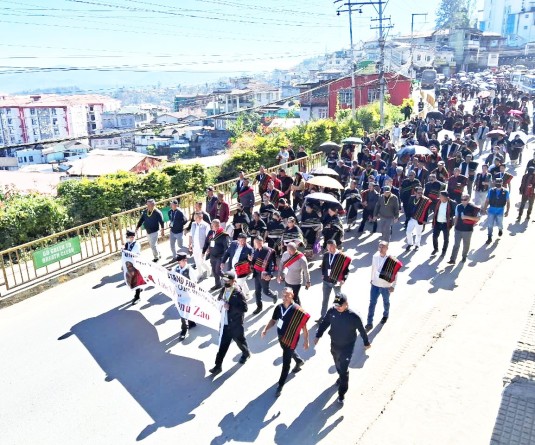
Morung Express News
Kohima | October 9
Recognizing the increasing demand for gender statistics to bring about gender parity and equity through ‘Gender empowerment policies’, the Department of Economics and Statistics has come up with the ‘Gender Statistics Nagaland 2016’ to collect and collate gender-wise disaggregate data.
This was released on October 9 at the Directorate of Economics and Statistics by Commissioner and Secretary, Department of Economics and Statistics Himato Zhimomi.
Kevileno Angami, IES, OSD, Planning & Coordination, and former Secretary, Economics and Statistics informed that the collection is the first gender-wise publication which throws light on the status of both men and women in different fields.
“However, focus has been placed on the socio-economic status of women, on issues of violence against women, political participation of women, status of women in the labour force, employment, health and education sectors to underscore the outcome of women specific programs to bring to them at par with men,” Angami stated.
The findings of the reports indicates the improved as well as regressing status of women in recent years especially in the areas of population, health, education, economy and the social and political participation in the State.
Population and related Statistics
Collecting data from the 2011 Census, the report informed that the sex ratio at birth during 2011 was 873, which marginally increased to 897 during 2015. AS per census 2011, in the unmarried category, females in the age group in 15-29 years comprised of 35.55% while females within the age group of 30-59 years consist of 4.90%.
Health Statistics
In 2014, the male and female Infant Mortality Rates (IMR) were 0.19 and 0.15 respectively. The report also informed that the overall IMR in Nagaland has reduced substantially from 1.58 in 2011 to 0.17 in 2014 indicating improvement in the health mechanism for infants.
Although the number of females (37618) in the registration of live birth is lower compared to males (41921) in 2015, in the registration of male deaths is at a higher number (3822) compared to female death (3134) in 2011. The numbers declined to 542 for females in 2015 and 1527 for males.
Dimapur, Phek, Kiphire and Mon have higher prevalence of anemia in women within the age group of 15-49 years. Dimapur, Peren and Kiphire have higher prevalence of aneamia among pregnant women in the same age group.
Education
Apart from the 2011 census findings, the report also indicated that during 2015-16, the Gross Enrolment ratio (GER) for females at the primary level stood at 110.35 compared to 108.65 for males. At the middle class level, the GER for females was 82.22 against 78.19 for males. Dimapur has the highest overall GER while Longleng has the lowest GER. As per the Directorate of School Education reports, the dropout rates in the primary level during 2015-16 were 2.91 for females and 3.95 for males. In the middle level the rate was 1038 for females and 10.67 for males. Longleng has the highest number of dropouts.
Participation in Economy
A striking feature in the categories of workers is that the percentage of female cultivators (65.2 %) and female agricultural laborers (7.3%) is higher than the male cultivators (47.4 %) and agricultural laborers (5.8%).
In the 6th Economic Census 2010, DES the percentage of female employees engaged in non-agricultural sector is only 33.39 percent while male employees comprise of 66.61 percent.
Within 2014-15, female employment in the public sector constituted 23.5 % of total employment, while in the private sector, the female employment comprised of 48.6 percent of the total workforce. The statistics also indicated that Dimapur has the highest percentage of female employees in public sector and Mon has the highest percentage of females in private sector.
Participation in decision making
While female voters have increased in the General State Elections from 80.51 percent in 1969 to 91.22 percent in 2013, the Gender Statistics Nagaland 2016 points out that from 1969 till 2013, no female contestant has been elected in the State Assembly. There were only two female candidates in the 2nd general election to State Assembly in 1969 which remained almost the same during the 12th general election in 2013 as against 142 and 187 number of male contestants during the respective years, mentioned the Gender Statistics Nagaland 2016. In the Lok Sabha General election, two women contested in the 6th and 7th General election in the year 1977 and 1980 where one woman managed to get elected in the 1977 elections.
Social obstacles in women’s empowerment
Forms of violence such as abuse, rape and molestation have increased, whereby in 2015 92 cases of crimes against women were registered in Nagaland with Dimapur district having the highest number followed by Kohima. Among the crimes, the cases of rape with 35 incidents were recorded the highest.
During the release, Himato Zhimomi IFS Commissioner and secretary stated that the economic and statistics is very important for the state which will enable the strengthening of the State. “The economic and statistics data allow the government and policy makers to plan for the present and future.” said Zhimomi adding that it also must provide accurate and correct inputs and therefore urged the department to conduct quality research and suggest some corrective measures.


.jpg)


.jpg)
